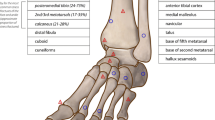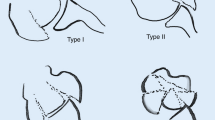Abstract
The management of open fractures in the multiple trauma patient is discussed. It is concluded that operative stabilization of the open fracture both enhances the survival of these patients and reduces the complications of the fracture while enhancing extremity function. This procedure must be conducted so as to avoid devascularization of more tissue and especially bone fragments and so that adequate stability is provided. In general, all open fractures are left open with the degree of openness depending upon the magnitude of the soft tissue trauma. In grade I and II open fractures, stabilization can usually be achieved by internal fixation or by a combination of minimal internal fixation (usually lag screws) and external fixation. In grade III open fractures, stabilization is usually best achieved by external fixation. However, the external fixation must be carefully designed to allow the subsequent soft tissue coverage operations which are usually required in third degree open fractures. In general, the external fixator should be viewed as a device to gain sufficient stability for patient mobilization and soft tissue management and not as definitive fracture care. For this reason, in the tibia unilateral frames are usually best and bilateral or trilateral frames should be reserved for segmental defects and severe zonal comminution. Definitive fracture care is then administered after soft tissue healing by cast or internal fixation.
Résumé
Le traitement des fractures ouvertes du polytraumatisé est soumis à discussion. Cet étude permet d'affirmer que l'immobilisation chirurgicale des fractures ouvertes augmente le taux de survie des traumatisés et réduit celui des complications et améliore le pronostic fonctionnel. La technique doit éviter la dévascularisation des tissus, en particulier des fragments osseux de façon à obtenir une bonne consolidation.
Généralement toutes les fractures ouvertes restent exposées, le degré de l'exposition dépendant de l'importance du traumatisme des parties molles. Dans les fractures ouvertes de type I ou II la stabilisation est habituellement obtenue à l'aide du fixateur interne; elle est complétée ou non par un fixateur externe. Dans les fractures de type III la réduction est assurée par fixation externe. Dans ce cas la fixation externe doit être choisie avec soin de façon à permettre ultérieurement la couverture chirurgicale de l'os par les parties molles, couverture qui est nécessaire pour ce type de fracture.
Le fixateur externe doit être choisi pour assurer une stabilité suffisante permettant la mobilisation du blessé et le traitement des lésions des parties molles plutôt que pour assurer le traitement définitif de la fracture. Pour cette raison la fracture du tibia est traité par cadres unilatéraux alors que les cadres bilatéraux ou trilatéraux sont réservés aux fractures comminutives ou présentant des pertes de substance osseuse. Le traitement definitif de la fracture est reportée à une periode, quand les lésions des parties molles sont cicatrisées, le traitement définitif de la fracture étant guéri par plâtre ou par fixateur interne.
Similar content being viewed by others
References
Burri, C.: Post Traumatic Osteomyelitis. Bern, Hans Huber, 1975
Weber, B.G., Cech, O.: Pseudoarthrosis. Bern, Hans Huber, 1976
Goris, R.J.A.: The injury severity score. World J. Surg.7:0 0, 1983
Tscherne, H., Oestern, H.J., Sturm, J.: Osteosynthesis of major fractures in polytrauma. World J. Surg.7:80 (This Symposium), 1983
Rittman, W.W., Perren, S.M.: Cortical Bone Healing after Internal Fixation and Infection. Berlin-Heidelberg-New York, Springer-Verlag, 1974
Matter, P., Rittman, W.W.: The Open Fracture. Bern, Hans Huber, 1977
Bone, L., LaDuca, J., Seibel, R., Border, J.: Primary open reduction and internal fixation of open fractures. J. Trauma20:580, 1980
Mears, D.: Materials and Orthopaedic Surgery. Baltimore, Williams and Wilkins, 1979
Mathes, S.J., Nahai, F.: Clinical Atlas of Muscle and Musculocutaneous Flaps. St. Louis, C.V. Mosby, 1979
Border, J., LaDuca, J., Seibel, R.: Acute susceptibility to infection. In Trauma and Shock and Its Prevention in the Infection Prone Hospital Patient, J.F. Burke, G.Y. Hildick Smith, editors, Boston, Little Brown, 1978, pp. 209–227
Johansen, K., Bandyk, D., Thiele, B., Hansen, S.T.: Temporary intraabdominal shunts: Resolution of a management dilemma in complex vascular injuries. J. Trauma22:395, 1982
Muller, M.E., Allgöwer, M., Willenegger, H.: Manual of Internal Fixation. Berlin-Heidelberg-New York, Springer-Verlag, 1970
Brooker, A.F., Edwards, C.C.: External Fixation. The Current State of the Art. Baltimore, Williams and Wilkins, 1979
Seligson, D., Pope, M.: Concepts in External Fixation. New York, Grune and Stratton, 1982
Behrens, F.: Unilateral external fixation for severe lower extremity lesions: Experience with the ASIF (AO) tubular frame. In Concepts in External Fixation, D. Seligson, M. Pope, editors, New York, Grune and Stratton, 1982, pp. 279–293
Salter, R.B., Simmonds, D.F., Malcolm, B.W., Rumble, M.D., MacMichael, D., Clements, N.D.: The biological effect of continuous passive motion on the healing of full-thickness defects in articular cartilage. J. Bone Joint Surg.62A:1232, 1980
Author information
Authors and Affiliations
Rights and permissions
About this article
Cite this article
Allgöwer, M., Border, J.R. Management of open fractures in the multiple trauma patient. World J. Surg. 7, 88–95 (1983). https://doi.org/10.1007/BF01655916
Issue Date:
DOI: https://doi.org/10.1007/BF01655916




